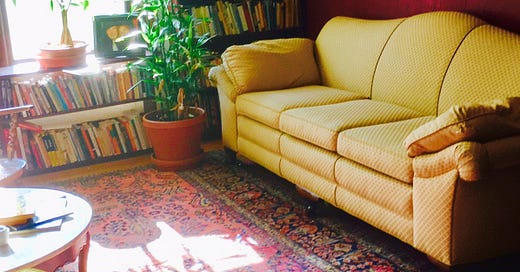A couple of buddies helped me move.
The vision of how I wanted this new chapter of my writing life to look grew out of the evening we had walked through that neighborhood in the dark. I imagined lots of bookshelves, lots of original art on the walls, hours writing at my desk in the mornings, cooking decent meals for myself in the galley kitchen, lowering the Murphy bed out of the wall at bedtime, hiding it away again in the morning, evenings reading in my favorite chair under a floor lamp, surrounded by my belongings.
My favorite chair, indeed the very chair I sit in now, is a Windsor style rocking chair with a rush seat. My oldest sister tells me that I had been rocked in it as an infant, but my earliest memory of the chair comes from when I rescued it from the attic of my mother and step-father’s “barn.” They were selling their property, and my mother was unloading all sorts of things on me because, at the time, I was closest at hand.
The chair’s history is murky. Where it came from before my infancy has never been explained to me, but at some point after that it had gone to my Aunt Jane, who painted it first pink and then black. When I got hold of it, I took that paint down to the wood and rubbed in Butcher’s Wax, a long, painstaking process, then had the tattered seat re-rushed.
In my new digs, I set my rocker on the battered Persian rug that had always been in our houses growing up, along with a deliciously comfortable camel-backed couch with feather pillows fitted into its wing-like arms. I’d bought this piece on one of the car trips across western Pennsylvania picking up and returning my young son Chris for weekend visits. We had a route we broke up with browsing through “antiques” and junk in a couple of shops along the way. On the way back from dropping Chris off with his mother on one such trip, I returned to our favorite shop and loaded the couch unto the roof rack of my VW Bug, then drove it home over the Allegheny Escarpment in a snow storm.
One of my other major finds on those car trips includes a hand-made 1904 edition of the Rubaiyat of Omar Khayyam, made by the Roycrofters, an Arts and Crafts Movement group I’d written about as an undergraduate American Studies major. The introduction was written by Clarence S. Darrow, of Monkey Trial fame. Elbert Hubbard, the leader, inspiration, and editor of the Roycrofters, went down with the Titanic. This relic cost me one dollar. I displayed it prominently on the coffee table in front of the couch.
I arranged my books on the shelves, found spots on the walls for family photos and paintings done my people I had met and been friendly with over the years. There was the abstract water color by Mona Brooks, who had been introduced to me by my sister Toni, and a couple pieces by Badri Narayan, an Indian painter and storyteller I knew from my time in Mumbai. One other favorite to show people was the lovely painting of Krishna I’d bought at a place outside Jaipur in India.
“I bought that to escape the people who kidnapped me on the Rajasthani Desert,” I told visitors.
Everything has a story and sometimes that story actually happened. That’s why these belongings mean so much to me. And this goes for everything from kitchen ware to my tribal carpets to my Air Force blues hanging in the back closet
In those first years at the apartment, we had a grocery store nearby, so picking up a few things for dinner was just a short walk away through the adjoining neighborhood. I imagined writing a lifestyle book called Chop Vegetables, Carry Groceries, a take off on Chop Wood, Carry Water, a book I had somewhere on one of my shelves. Indeed, I’d lived that life in a cabin in the Pennsylvania mountains just before grad school. It seemed a nice book idea, but I had the book I’d planned about my time in India to attend to first.
This description of setting up my new writing life makes it seem like a happy time, but I know better. Reaching back to remember, we can easily recolor the past to our liking. I don’t want to do that. Ending a relationship is painful. Nobody enjoys the emotional turmoil of a break-up. And I did not feel good about myself. My guilt for how I’d behaved to my wife makes me cringe as I look back now. “Time heals all wounds,” I remember telling her glibly. “Yes,” she quipped, as sharp-witted as ever, “and time wounds all heels.”
Her words were prophetic.
It was not a happy time. But it had to be. I took my belongings and all the stories that went with them and set myself up. I’d done this to myself. It was time to get down to work on that India book. I had to make the best of it, no matter my demons.



